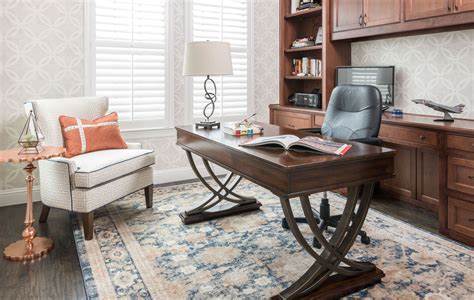With remote work becoming increasingly common, having a home office that is both functional and aesthetically pleasing has never been more important. A well-designed home office can enhance productivity, creativity, and overall well-being. Whether you’re working from home full-time or just need a dedicated space for household tasks, here are some tips for creating a home office that combines practicality with style.
1. Choose the Right Location
Selecting the right location for your home office is crucial for productivity and focus. Ideally, choose a quiet and well-lit area of your home away from distractions and noise. Consider factors such as natural light, proximity to power outlets, and access to high-speed internet. If you don’t have a spare room, a corner of the living room, bedroom, or even a well-designed closet can be repurposed as a functional workspace.
2. Invest in Quality Furniture
Invest in ergonomic and comfortable furniture that supports your posture and enhances productivity. Start with a sturdy desk that provides ample workspace for your computer, paperwork, and other essentials. Choose a comfortable chair with proper lumbar support and adjustable features to prevent strain and fatigue during long hours of sitting. Consider additional storage options such as shelves, cabinets, or drawers to keep your workspace organized and clutter-free.
3. Prioritize Lighting
Good lighting is essential for creating a productive and inviting workspace. Maximize natural light by positioning your desk near a window or using sheer curtains to diffuse sunlight. Supplement natural light with task lighting such as desk lamps or overhead lighting to reduce eye strain and create a well-lit environment for working. Choose light fixtures that complement your decor and provide adequate illumination for various tasks.
4. Declutter and Organize
Keep your home office tidy and organized to minimize distractions and maximize efficiency. Invest in storage solutions such as filing cabinets, storage bins, and desk organizers to keep paperwork, supplies, and electronics neatly organized and within reach. Declutter your workspace regularly by sorting through paperwork, clearing out unnecessary items, and maintaining a clutter-free environment conducive to focus and productivity.
5. Personalize Your Space
Make your home office feel like a welcoming and inspiring environment by adding personal touches and decor that reflect your personality and style. Display photos, artwork, or motivational quotes that inspire you and create a positive atmosphere. Incorporate plants or greenery to bring life and freshness into your workspace and improve air quality. Choose decor elements such as rugs, curtains, or accent pieces that complement your existing decor and create a cohesive look.
6. Create Zones for Different Tasks
Divide your home office into zones or areas dedicated to different tasks and activities. Designate specific areas for computer work, paperwork, brainstorming, and relaxation to optimize workflow and productivity. Use furniture arrangement, rugs, or room dividers to delineate separate zones within your workspace while maintaining a cohesive and functional layout.
7. Invest in Technology
Equip your home office with the necessary technology and equipment to support your work and communication needs. Invest in a reliable computer, high-speed internet connection, and essential peripherals such as a printer, scanner, and phone. Consider ergonomic accessories such as a keyboard tray, monitor stand, or wireless mouse to improve comfort and efficiency while working.
8. Consider Acoustics
Pay attention to acoustics in your home office to minimize distractions and ensure privacy during virtual meetings or phone calls. Incorporate sound-absorbing materials such as rugs, curtains, or acoustic panels to reduce echo and noise levels in your workspace. If necessary, use noise-canceling headphones or a white noise machine to create a quiet and conducive environment for concentration and focus.
9. Plan for Flexibility
Design your home office with flexibility in mind to accommodate changing work needs and preferences. Choose modular furniture that can be easily rearranged or reconfigured to adapt to different tasks and activities. Incorporate flexible storage solutions that allow for easy organization and access to supplies and equipment. Create a versatile workspace that can transition seamlessly between work, creativity, and relaxation as needed.
10. Maintain Cleanliness and Order
Finally, maintain cleanliness and order in your home office to promote a productive and harmonious work environment. Establish a regular cleaning routine to dust surfaces, vacuum floors, and tidy up clutter. Keep electronic devices and cables organized and free of dust to prolong their lifespan and ensure optimal performance. By maintaining a clean and organized workspace, you can create a conducive environment for focus, creativity, and success.
Conclusion
Creating a functional and stylish home office is essential for maximizing productivity, comfort, and well-being while working from home. By choosing the right location, investing in quality furniture, prioritizing lighting, decluttering and organizing, personalizing your space, creating zones for different tasks, investing in technology, considering acoustics, planning for flexibility, and maintaining cleanliness and order, you can design a home office that meets your needs and reflects your personal style. With careful planning and attention to detail, you can create a productive and inspiring workspace where you can thrive and succeed in your

